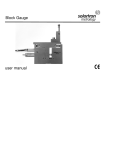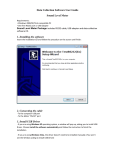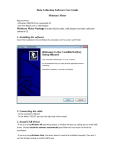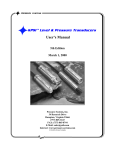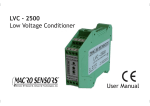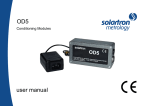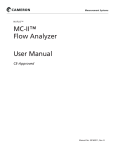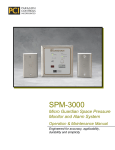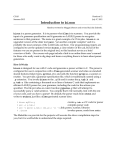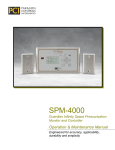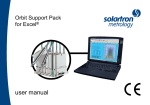Download OD4 Conditioning Module user manual
Transcript
OD4 Conditioning Module user manual 1.0: Index Section Title Page 1.0 Index . . . . . . . . . . . . . . . . . . . . . . . . . 1 2.0 Safety Information . . . . . . . . . . . . . . . . 2 3.0 Introduction . . . . . . . . . . . . . . . . . . . . . 4 3.1 OD4 Mk2 Enhancements . . . . . . . . . . . . 4 4.0 Installation . . . . . . . . . . . . . . 5 4.1 Mounting . . . . . . . . . . . . . . 5 4.2 Operational Environment . . . . . . . . . . . . . . 6 4.2.1 Residential, Commercial & Light Industrial Environments . . . . . 6 4.2.2 Industrial Environments . . . . . . . . . . . . 6 4.3 Electrical Connections . . . . . . . . . . . . . . . 7 4.4 Connecting the Transducer . . . . . . . . . . 9 4.5 Connecting the Power Supply . . . . . . . . . 10 4.6 Connecting the Signal Out . . . . . . . . 10 1.0 Index Section Title Page 4.6.1 Voltage Connections. . . . . . . . . . . . . . . 10 4.6.2 Current Connections . . . . . . . . . . . . 11 4.7 Using an EMC Cable Gland . . . . . . . . 12 5.0 Setting up the Transducer and OD4 . . . 13 5.1 Links Explained . . . . . . . . . . . . . 14 5.2 Basic Procedure . . . . . . . . . . . . . . . . 15 5.3 Sensitivity and the X2, X4,DIV2 Links . . . . 19 6.0 Half-Bridge Version. . . . . . . . . . . . . 20 7.0 Specifications . . . . . . . . . . . . . . . . 20 7.1 Electrical . . . . . . . . . . . . . . . . . . . . . 20 7.2 Mechanical and Connections . . . . . . . . . 22 7.3 Environmental. . . . . . . . . . . . . . . . 22 7.4 Notes . . . . . . . . . . . . . . . . . . . .23 Return Of Goods 1 Solartron Sales Offices Part No. 502621 Issue 8 2.0: Safety Information Terms in this Manual WARNINGS: WARNING statements identify conditions or practices Do not operate in explosive atmosphere that could result in personal injury or loss of life. To avoid explosion, do not operate this equipment in an explosive atmosphere. CAUTION statements identify conditions or practices Safety Critical Environments that could result in damage to the equipment or other This equipment is not intended for use in a safety property. critical environment. CAUTION: Low Voltage This equipment operates at below the SELV and is Symbols in this manual therefore outside the scope of the Low Voltage This symbol indicates where applicable Directive. cautionary or other information is to be found. This equipment is designed to work from a low voltage DC supply. Do not operate this equipment outside of specification. 2.0: Safety Information 2 Part No. 502621 Issue 8 2.0: Safety Information CAUTION: Electrostatic Discharge This equipment is susceptible to ESD (Electrostatic Discharge) when being installed or adjusted, or whenever the case cover is removed. To prevent ESD related damage, handle the conditioning electronics by its case and do not touch the connector pins. During installation, follow the guidelines below. - Ensure all power supplies are turned off. - If possible, wear an ESD strap connected to ground. If this is not possible, discharge yourself by touching a metal part of the equipment into which the conditioning electronics is being installed. - Connect the transducer and power supplies with the power switched off. - Ensure any tools used are discharged by contacting them against a metal part of the equipment into which the conditioning electronics is being installed. - During setting up of the conditioning electronics, make link configuration changes with the power supply turned off. Avoid touching any other components. - Make the final gain and offset potentiometer adjustments, with power applied, using an appropriate potentiometer adjustment tool or a small insulated screwdriver. 2.0: Safety Information 3 Part No. 502621 Issue 8 3.0: Introduction The OD4 MK2 is a development of the original OD4. It is a compact conditioning module powered from a single DC supply. Adjustable gain and zero controls are provided for use with the complete range of Solartron LVDT and halfbridge transducers.* The unit is of robust construction, housed in a die cast aluminium box providing a substantial degree of mechanical protection. The OD4 MK2 incorporates its own voltage regulation for operation from 10-30 VDC and can provide outputs of up to ±10 V together with ±20 mA. 3.1: OD4 MK2 Enhancements The OD4 MK2 has been designed as a form, fit and function replacement for the original OD4, but with several enhancements. - Wider gain range, allowing ALL Solartron transducers to be connected without the need for attenuation resistors. - Up to ±10 V dc and ±20 mA are available for all gain settings. - Fixed and variable offsets make setting of uni-polar output easier. - Gain and offset adjustment are fully independent. - Selectable transducer excitation frequency. - Selectable transducer load resistances. - Selection between forward and reverse connection. - Fully CE Compliant. - Half-Bridge transducers can now be accommodated with simple plug wiring changes.* * For half-bridge only variant see section 6.0. 3.0: Introduction 4 Part No. 502621 Issue 8 4.0: Installation 4.1: Mounting The OD4 may be mounted in a variety of ways and in any attitude. Ensure that there is enough space for the cover to be removed to allow for internal adjustments. Space should also be allowed for the transducer connector, EMC glands (if fitted) and cabling. It is recommended that the OD4 case be connected to earth or chassis. This earth connection is not a safety earth, but is part of the overall electrical screening scheme. Underside Mounting Top-Side Mounting Note: If replacing OD4 MKI a retrofit mounting kit is available if repositioning holes is not possible. 4.0: Installation 5 Part No. 502621 Issue 8 4.0: Installation (continued) 4.2: Operational Environment This section discusses the type of installation required depending on the electrical environment. 4.2.1: Residential, Commercial and Light Industrial Environments Typically, this will be an office, laboratory or industrial environment where there is no equipment likely to produce high levels of electrical interference, such as welders or machine tools. Connections may be made using twisted, unscreened wire. This is a cost effective option and will give good performance in this environment. Standard equipment wire such as 7/0.2 (24AWG) can be twisted together as required. Standard data cable such as generic CAT5 UTP will also give good performance. 4.2.2: Industrial Environments Typically, this will be an industrial environment where there is equipment likely to produce high levels of electrical interference, such as welders, machine tools, cutting and stamping machines. Connections should be made using screened cable. Braided or foil screened cables may be used. The cable screen should be connected to the OD4 case at cable entry point. The case of the OD4 should be connected to a local ground. An EMC cable gland is recommended. This is supplied with the OD4. When selecting the type of wire or cable to be used, consider the following parameters: - Screening. - Conductor size (resistance). - Mechanical aspects such as flexibility and robustness. This is not a complete list. Installations may require other special cable characteristics. 4.0: Installation 6 Part No. 502621 Issue 8 4.0: Installation (continued) 4.3: Electrical Connections The OD4 requires three connections. 1. Transducer. 2. Power Supply. 3. Output Signal, Voltage or Current. A small hole should be made in the grommet prior to passing the wires through. If a screened cable is to be used, an EMC cable gland is recommended (see section 4.7). For best performance in electrically noisy environments, the case of the OD4 should be connected to a local earth. This can be achieved via the mounting bracket. This earth connection is not a safety earth, but is part of the overall electrical screening scheme. The wiring layout arrangements are similar for OD4 fitted with EMC glands and screened cable. Signal Out FINE GAIN Transducer FINE OFFSET NULL Power Supply OUTPUT FREQ LO COARSE GAIN (ON) 1 2 3 4 5 6 (7) HI (OFF) +VE POWER 0V V OUT 0V I OUT Separate Power Supply and Signal Out wires -VE +VE 5V 10V COARSE OFFSET G BK W R B 10K 2K -¦R¦ |F| -DIV 2 X2 X4 4.0: Installation 7 Part No. 502621 Issue 8 4.0: Installation (continued) 4.3: Electrical Connections Power Supply and Signal Out wires from one end only Signal Out Transducer FINE GAIN FINE OFFSET NULL Power Supply OUTPUT FREQ LO COARSE GAIN (ON) 1 2 3 4 5 6 (7) HI (OFF) +VE POWER 0V V OUT 0V I OUT Connections to the power supply should be routed to one side as shown. This helps to reduce interference between power supply wires and the more sensitive parts of the circuitry. -VE +VE 5V 10V COARSE OFFSET G BK W R B 10K 2K -¦R¦ |F| -DIV 2 X2 X4 A technical note explaining good practice for cable installation and routing can be downloaded from www.solartronmetrology.com. 4.0: Installation 8 Part No. 502621 Issue 8 4.0: Installation (continued) 4.4: Connecting the Transducer Transducers fitted with a 5-pin DIN plug are simply screwed into the case mounted socket. Transducers not fitted with a plug should be wired to the plug supplied. For the half-bridge only variant see section 6.0. Blue Green Half-Bridge Electrical Connections Red and White In Phase for Inward Displacement Black Transducer Body Ground CORE Secondary Centre Tap Primary VA Green and White Signal Yellow Blue Energising Ve Yellow Measured Output Energising Yellow Signal VA In Phase for Inward Red and Yellow Displacement Centre Tap VB Red and Blue CORE LVDT Electrical Connections Red and Blue VO Black Yellow Centre Tap VO Transducer Body Ground VB Red Red White Standard LVDT Gauging Probe Plug Connections Standard Half-Bridge Gauging Probe Plug Connections Black Black Cable Screen Cable Screen Blue LVDT Half-Bridge Case White Blue 3 + 4 + 4 2 5 1 Yellow 5 1 - Green Red Red Plug view into pins Case Note 1: + indicates inward movement of the tip. Note 2: The transducer body may be disconnected from the cable screen by cutting the black wire inside the connector 4.0: Installation Case 3 2 Yellow Case LINK Plug view into pins Note 1: + indicates inward movement of the tip. Note 2: The transducer body may be disconnected from the cable screen by cutting the black wire inside the connector 9 Part No. 502621 Issue 8 4.0: Installation (continued) 4.5: Connecting the Power Supply The OD4 requires a dc power supply in the range 10-30 V. A fully regulated supply is not required, but the voltage at the input to the OD4 must remain within specification. Ideally, the 0 V at the power supply should not be connected to earth or the chassis, as this would result in ground loops being formed. The 0 V supply, 0 V signal and case are all internally connected together at the OD4. 4.6: Connecting the Signal Out The output signal may be voltage or current. 4.6.1: Voltage Connections Voltage can easily be monitored using a variety of instrumentation such as voltmeters. Voltage drops along wires contribute to measurement errors, so care must be taken when using long cable lengths (100 m for example). High impedance instruments are more prone to interference. Power Supply + 10-30 V 0V Process Monitor Iout 0V Vout 0V +VE + Voltage The signal 0 V should always be used as reference. If power supply 0 V is used, then error voltages may be introduced. 4.0: Installation 10 Part No. 502621 Issue 8 4.0: Installation (continued) 4.6.2: Current Connections Current output requires the use of purposely designed current input instrumentation. Current output is more suitable for transmitting over longer distances because current is not lost due to wiring resistance. Additionally, with a low impedance, a current loop is less likely to pick up noise. Process Monitor Power Supply + + 10-30 V 0V 0V Iout 0V Vout +VE Current The total loop resistance (resistance of measuring equipment and wiring) must not exceed specification. Note: The OD4 is not loop-powered, so a power supply must not be used in-line with the current output. 4.0: Installation 11 Part No. 502621 Issue 8 4.0: Installation (continued) 4.7: Using an EMC Cable Gland To ensure the cable screen is properly connected to the OD4 case, an EMC cable gland should be used. This is supplied as an optional extra. The diagrams below assume a single 4-way cable is being used. Remove the grommet and fit the cable gland as shown below. 30 mm 10-15 mm 125 mm Rotate Gland Body to Tighten Screen Case Wall - Prepare cable as shown. Sealing Ring - Slide the Dome nut, sealing ring and plastic insert over cable. Rolled Back Screen - Fold and roll the screen back over itself to form a lump. - Push cable into gland body followed by the plastic insert (ensure anti-rotation slots engage), sealing ring and Dome nut. - Ensure all components are properly seated before tightening the dome nut. 4.0: Installation 12 Dome Nut Plastic Insert Gland Body Part No. 502621 Issue 8 5.0: Setting up the Transducer and OD4 The OD4 may be set-up with output signals anywhere within a ±10 VDC or ±20 mA range. Typical outputs are ±10 VDC, ±5 VDC, 0-10 VDC and 4-20 mA. These procedures apply to voltage and current output. Voltage and current output are available at the same time, although they cannot be individually adjusted. Either voltage or current should be chosen as the calibration reference. All outputs use 0 V signal as the signal reference. A list of standard link settings is available, see section 5.2. CAUTION: During installation and adjustment, the top of the enclosure has to be removed for access to user adjustments. At this time, standard ESD handling precautions for electronic equipment should be followed. 5.0: Setting up the Transducer and OD4 13 Part No. 502621 Issue 8 5.0: Setting up the Transducer and OD4 (continued) 5.1: Option Links - Explained The table below and subsequent diagrams explain the link functions and show the factory setting. Link Options Standard Setting 1 link on Positron 1 to 6 Link ON Position 1 Course Gain Description Sets the basic gain Fine Gain Adjustment between course gain ranges Potentiometer Adjustment Mid Position Course Offset Shifts the output by a fixed amount No offset - Links Parked Fine Offset Fine trim around any fixed offset Link ON -VE or +VE and Link ON 5V or 10V No offset - Link Parked Potentiometer Adjustment (7) Null Used during set-up to null output ON, OFF OFF Freq. Selects transducer primary frequency Mid Position Hi Freq. - Link Parked 100kΩ Parked, 10kΩ - ON, 2kΩ - ON 100KΩ - Link Parked Polarity (FR) Enables output signal direction change 2 Links across Forward or Reverse F Position - 2 Link ON Input Gain Input Gain of x1, x2, x4 or divide 2 X1 - Parked, X2 - ON, X4 - ON, DIV2 - ON Link parked on X2 FINE GAIN FINE OFFSET NULL OUTPUT FREQ LO COARSE GAIN (ON) 1 2 3 4 5 6 (7) HI (OFF) +VE POWER 0V V OUT 0V I OUT Lo - ON, Hi - Parked Input Resistance Sets transducer secondary load -VE +VE Link ON Link PARKED 5V Link OFF 10V COARSE OFFSET G BK W R B 10K 2K -¦R¦ |F| -DIV 2 X2 X4 5.0: Setting up the Transducer and OD4 14 Part No. 502621 Issue 8 5.0: Setting up the Transducer and OD4 (continued) 5.2: Basic Procedure To set-up the OD4, some basic steps should be followed. The following steps describe a typical setting procedure and applies to most applications. Other procedures may be used as appropriate. Step 1 Step 2 Set-up OD4 links Align OD4 and Transducer Null V/V ±V Hz Ω KΩ Zero Step 3 Set OD4 and Transducer Range -5V electronics +5V Zero electronics Step 4 Step 5 Add Offset if Required Final Checks 0V Shift zero +5V electronics transducer transducer transducer Null Null Null +10V For a bi-polar output i.e. ±10 VDC or ±20 mA, follow steps 1 to 3. For a uni-polar output i.e. 0-10 V, 0-20 mA or 4-20 mA, follow steps 1 to 4. In either case, step 5 (final checks) should be followed on the completion of the set-up. 5.0: Setting up the Transducer and OD4 15 Part No. 502621 Issue 8 5.0: Setting up the Transducer and OD4 (continued) 5.2: Basic Procedure STEP 1 - Set-up OD4 Links If the transducer characteristics are known, set the frequency and input resistance links as required. A list of standard settings for all Solartron transducers is available from www.solartronmetrology.com. If the transducer characteristics are not known, the standard link settings should be used. If your transducer is known to be outside of the standard sensitivity range, the X2 or DIV2 links will have to be used. See section 5.3. STEP 2 - Align OD4 Null and Transducer Null Null the OD4. 1. Put the Gain link on position (7) as shown. This allows any electronics offset in the output stage to be removed. 2. Adjust the Fine Offset control to give as near to zero output as practical. Null the transducer. 1. Replace the Gain link to the original position. 2. Adjust the position of the transducer to give as near to zero output as practical. This is the centre of the mechanical range. NULL Any electrical offset in the OD4 is removed. The transducer position is adjusted so that transducer and OD4 nulls are aligned. FREQ LO (ON) 1 2 3 4 5 6 (7) HI (OFF) If the transducer cannot be centered for practical reasons an offset will remain within the system. There may be noticeable interaction between Gain and Offset adjustment. This does not prevent the OD4 being set-up. However several iterations may be required when adjusting Gain and Offset. Please contact your supplier if guidance is required. 5.0: Setting up the Transducer and OD4 16 Part No. 502621 Issue 8 5.0: Setting up the Transducer and OD4 (continued) 5.2: Basic Procedure STEP 3 - Setting Bi-Polar Full-scale Output 1. Move the transducer to the position where maximum OD4 output is required. 2. If the polarity of the output is wrong, move the Polarity (FR) links to the R position (see link diagram). Move the transducer back and re-check the zero position. Adjust transducer position as required. Normal Output Polarity Reverse Output Polarity 10K 2K -¦R¦ |F| -DIV 2 X2 X4 10K 2K -¦R¦ |F| -DIV 2 X2 X4 3. Move the RANGE link between 1 and 6 until the OD4 output is near the required value. 4. Adjust the Fine Gain control to give the required output. 5. A bi-polar output has now been set, proceed to step 5. If a uni-polar output is required, proceed to step 4. Example: ±10 VDC is required from a ±1 mm transducer. Set the transducer to +1 mm and set the output to 10 V. If your transducer is known to be outside of the standard sensitivity range, the X2 or DIV2 links will have to be used. See section 5.3. 5.0: Setting up the Transducer and OD4 17 Part No. 502621 Issue 8 5.0: Setting up the Transducer and OD4 (continued) 5.2: Basic Procedure STEP 4 - Setting Uni-polar Full-Scale Output (adding an offset) 1. Move the transducer to the null position. OD4 output will be 0 V or 0 mA. 2. Apply offset using the +VE, -VE, 5 V and 10 V links and then adjust the Fine Offset control to set the offset precisely. 3. Perform final checks, step 5. Example: 0-10 V is required for a ±1 mm transducer. Set the transducer to give ±5 V over the full range and then, with the transducer at null, add +5 V offset. Adjust the Fine Offset control to give 5 V. When the transducer is moved to the +1 mm position, the output will be +10 V. Example: 4-20 mA is required for a ±1 mm transducer. Set the transducer to give ±8 mA over the full range and then, with the transducer at null, add +5 V (approx. 10 mA) offset. Adjust the Fine Offset control to give +12 mA. When the transducer is moved to the +1 mm position, the output will be +20 mA. STEP 5 - Final Checks Ensure that the calibration is correct by moving the transducer across the required mechanical range, checking calibration points. Fine adjustment can be made if required. It may only be possible to set the output accurately at the two calibration points. This is due to non-linearity within the transducer. 5.0: Setting up the Transducer and OD4 18 Part No. 502621 Issue 8 5.0: Setting up the Transducer and OD4 (continued) 5.3: Transducer Sensitivity and the X2, X4, DIV2 Link The OD4 compensates for changes in primary signal amplitude by producing an internal error signal that is the ratio between the primary and secondary signals. If the transducer output signal is too high or too low, errors may occur that can degrade the performance of the OD4 / transducer combination. For these transducers, the X2, X4 or DIV2 input gain link must be used. For Solartron transducers, consult the list of standard settings available from the downloads section of www.solartronmetrology.com. Transducer Full Range Output In general, transducer sensitivity is quoted as mV/V/mm Where: mV is the output of the transducer V is the primary voltage mm is the mechanical position of the transducer from null (usually mid mechanical range). To get the transducer Full Range Output, multiply all three together. Example: AX/1.0 sensitivity is 210 mV/V/mm AX/1.0 range is ±1 mm OD4 primary voltage 3 V Transducer Full Range Output = 210 x 3 x 1 = 630 mV (0.63 V) Set the X2, X4, DIV2 link as shown in the table below. Transducer Full Range Output 400 mV FR to 2500 mV FR 2500 mV FR to 5000 mV FR 150 mV FR to 400 mV FR 55 mV FR to 150 mV FR 5.0: Setting up the Transducer and OD4 Input Gain Link Setting Standard Range - Link Parked on X2 High Transducer Output - Link ON DIV2 Low Transducer Output - Link ON X2 Very Low Transducer Output - Link ON X4 19 Part No. 502621 Issue 8 6.0: Half-Bridge only Variant This is a half-bridge optimised variant of the standard product. The excitation frequency is higher (see specification) and the transducer input connector is wired to accept half-bridge transducers with standard connections. 6.1: Connecting the transducer The 5-pin DIN plug is screwed into the case mounted socket. Transducers not fitted with a plug should be wired to the plug supplied. LVDT transducers cannot be connected to this input. Blue Standard Half-Bridge Gauging Probe Plug Connections Black VA CORE Cable Screen Half-Bridge Blue Case VO 3 + VB 4 2 5 1 Red Yellow Half-Bridge Electrical Connections Red and Blue Energising Yellow Signal Red and Yellow In Phase for Inward Displacement Black Transducer Body Ground Red Case Yellow Centre Tap Plug view into pins Note 1: + indicates inward movement of the tip. Note 2: The transducer body may be disconnected from the cable screen by cutting the black wire inside the connector 6.2: Setting up the Half-Bridge Transducer The setting up procedure is the same as LVDT transducers. See section 5. The sensitivity of half-bridge transducers is generally lower than for LVDT types, the x2 and x4 gain position may have to be used. A list of standard link settings for all Solartron Transducers is available from the downloads section of www.solartronmetrology.com. 6.0: Half-Bridge only Variant 20 Part No. 502621 Issue 8 7.0: Specifications 7.1: Electrical Parameter Power Supply Typical Voltage / Current Voltage Range Current Range Value 24 VDC at 55 mA 10 to 30 VDC 140 mA at 10 V to 50 mA at 30 V Transducer Excitation Energising Voltage Energising Frequency 3 Vrms nominal 2.5 kHz (Lo) or 5 kHz (Hi) nominal 10 kHz (Lo) or 13 kHz (Hi) Energising Current Special 7.0: Specifications see note 1 link selectable Half-Bridge version only 30 mA max. Transducer Signal Input Input Signal Range Standard Input Load Resistance Options Comments 400 to 2500 mV FR DIV2 2500 to 500 mV FR x2 150 to 400 mV FR x4 55 to 150 mV FR 6 gain ranges (applies to LVDT only) see note 2 2, 10, 10 kΩ Forward and Reverse LVDT Input Half-Bridge Input link selectable link selectable standard special plug wiring or half-bridge version only 21 Part No. 502621 Issue 8 7.0: Specifications (continued) 7.1: Electrical Parameter Value Comments Signal Output Output Output up to ±10 VDC into 1 kΩ <1 mVrms up to ±20 mA into 150 Ω load see notes 3 and 4 ±5 VDC (approx 10 mA) fixed ±10 VDC (approx 20 mA) fixed ±2.8 VDC (approx 5.6 mA) link selectable link selectable Variable (adds to fixed offsets) Output Voltage Range Residual Noise Current Output Offset Coarse Fine Temperature Coefficient Gain Temperature Coefficient Offset Warm-Up Linearity Bandwidth (-3dB) Protection (see note 6) Power Supply Inputs and Outputs Certification (see note 7) Immunity Emissions 7.0: Specifications see note 5 <0.01% FRO/°C <0.01% FRO/°C 15 minutes recommended <0.1% FRO 500 Hz typical Reverse connection protected Short circuit protected Transient and ESD Protected BS EN61000-6-2:2001 BS EN61000-6-3:2001 22 Immunity for Industrial Environments Emission for Residential, commercial and light-industrial environments Part No. 502621 Issue 8 7.0: Specifications (continued) 7.2: Mechanical and Connections Parameter Value Comments Transducer Power Supply Output Signal Enclosure - Size Weight Material of Case 5-pin circular DIN Internal Terminal Block Internal Terminal Block 120 x 65 x 40 mm 300 g (0.66 lbs) approx. Die-Cast Zinc Alloy (painted) Excluding connectors 7.3: Environmental Parameter Value Operating Temperature Range Storage Temperature Range IP Rating 0 - 60°C -20 - 85°C IP40 7.0: Specifications Comments 23 Part No. 502621 Issue 8 7.0: Specifications (continued) 7.4: Notes 1. Primary voltage absolute value and drift is not specified. The OD4 uses ratiometric techniques to compensate for primary voltage drift. 2. The way in which the OD4 functions means a special configuration must be used for transducers outside of the standard range. This is selectable by links. The majority of Solartron LVDT transducers are within the standard range. See section 5. 3. OD4 can drive into a 1 kΩ load but this offers no advantage. 10-100 kΩ is recommended. 4. Output voltage range can be adjusted as required anywhere within this range by using a combination of gain and offset, for example. ±10 VDC, ±5 VDC, 0-5 VDC, 0-10 VDC, 4-20 mA. 5. Current output may be used at the same time as voltage output. Calibration of voltage and current cannot be individually adjusted. 6. Protection applies to the product when fully installed according to the user manual. During installation the top of the enclosure has to be removed for access to user adjustments. At this time standard ESD handling precautions for electronic equipment should be followed. 7. The OD4 complies with the toughest electrical emissions and immunity regulations. Compliance requires installation according to the user manual. Compliance does not guarantee performance as the installation environment may be outside of test specification limits. The flexibility of OD4 means it can be installed in a variety of ways according to user requirements. Simple installations with short non-screened cables will meet the lesser light-industrial immunity regulations. Heavy industrial installations, especially with longer cables, will need more careful installation with screened cables. 7.0: Specifications 24 Part No. 502621 Issue 8 Return of Goods Devices returned for service/repair/calibration should be shipped prepaid to your distributor or, if purchased directly from Solartron Metrology, to the relevant Sales Office (see below). The shipping container should be marked: "For the Attention of the Returns Department" The following information should accompany the device(s): 1. Contact details of company/person returning device, including return shipping instructions. repair. Customer damage and any device found, upon inspection, to have no fault will be considered nonwarranty. Please contact the Sales Office or Distributor for warranty terms, service options and standard charges. Adherence to these procedures will expedite handling of the returned device and will prevent unnecessary additional charges for inspection and testing to determine the condition. Solartron Metrology reserves the right to repair or replace goods returned under warranty. 2. A statement of service required and purchase order. 3. Description of the device fault and the circumstances of the failure, including application environment and length of time in service. 4. Original purchase order number and date of purchase, if known. Please note: A standard assessment charge is applicable on all non-warranty devices returned for All repairs are guaranteed for 3 months (unless otherwise stated). Solartron Metrology reserves the right to make changes without further notice to any products herein to improve reliability, function or design. Solartron Metrology does not assume any liability arising out of the application or use of any product or circuit described herein, neither does it convey any licence under patent rights nor the rights of others. SOLARTRON METROLOGY OFFICES OFFICES WORLDWIDE - Addresses for Repairs France Germany United Kingdom U.S.A. Solartron Metrology Z.I. du Bois Chaland 2, rue du Bois Chaland CE 5611 Lisses Evry Cedex, 91056 Solartron Metrology Wittekindstrasse 12 45470 Mülheim/Ruhr Solartron Metrology Steyning Way Bognor Regis West Sussex PO22 9ST Solartron Metrology 10770 Hanover Road Forestville NY 14062 Tel: +33 (0) 1 69 64 47 47 Fax: +33 (0) 1 69 64 47 49 Tel: +49 (0) 208 31026 Fax: +49 (0) 208 31441 Tel: +44 (0) 1243 833333 Fax: +44 (0) 1243 833332 Tel: +1 (716) 965 4100 Fax: +1 (716) 965 4144 [email protected] [email protected] [email protected] [email protected] www.solartronmetrology.com Solartron Metrology Ltd. is a subsidiary of The Roxboro Group Plc. Solartron pursues a policy of continuous development. The specifications in this document may therefore be changed without notice Solartron Metrology. A Roxboro Group Company



























